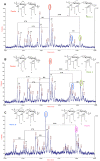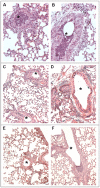Pseudomonas aeruginosa exploits lipid A and muropeptides modification as a strategy to lower innate immunity during cystic fibrosis lung infection
- PMID: 20037649
- PMCID: PMC2793027
- DOI: 10.1371/journal.pone.0008439
Pseudomonas aeruginosa exploits lipid A and muropeptides modification as a strategy to lower innate immunity during cystic fibrosis lung infection
Abstract
Pseudomonas aeruginosa can establish life-long airways chronic infection in patients with cystic fibrosis (CF) with pathogenic variants distinguished from initially acquired strain. Here, we analysed chemical and biological activity of P. aeruginosa Pathogen-Associated Molecular Patterns (PAMPs) in clonal strains, including mucoid and non-mucoid phenotypes, isolated during a period of up to 7.5 years from a CF patient. Chemical structure by MS spectrometry defined lipopolysaccharide (LPS) lipid A and peptidoglycan (PGN) muropeptides with specific structural modifications temporally associated with CF lung infection. Gene sequence analysis revealed novel mutation in pagL, which supported lipid A changes. Both LPS and PGN had different potencies when activating host innate immunity via binding TLR4 and Nod1. Significantly higher NF-kB activation, IL-8 expression and production were detected in HEK293hTLR4/MD2-CD14 and HEK293hNod1 after stimulation with LPS and PGN respectively, purified from early P. aeruginosa strain as compared to late strains. Similar results were obtained in macrophages-like cells THP-1, epithelial cells of CF origin IB3-1 and their isogenic cells C38, corrected by insertion of cystic fibrosis transmembrane conductance regulator (CFTR). In murine model, altered LPS structure of P. aeruginosa late strains induces lower leukocyte recruitment in bronchoalveolar lavage and MIP-2, KC and IL-1beta cytokine levels in lung homogenates when compared with early strain. Histopathological analysis of lung tissue sections confirmed differences between LPS from early and late P. aeruginosa. Finally, in this study for the first time we unveil how P. aeruginosa has evolved the capacity to evade immune system detection, thus promoting survival and establishing favourable conditions for chronic persistence. Our findings provide relevant information with respect to chronic infections in CF.
Conflict of interest statement
Figures







References
-
- Akira S, Uematsu S, Takeuchi O. Pathogen recognition and innate immunity. Cell. 2006;124:783–801. - PubMed
-
- Girardin SE, Boneca IG, Carneiro LA, Antignac A, Jéhanno M, et al. Nod1 detects a unique muropeptide from gram-negative bacterial peptidoglycan. Science. 2003;300:1584–1587. - PubMed
-
- Girardin SE, Travassos LH, Hervé M, Blanot D, Boneca IG, et al. Peptidoglycan molecular requirements allowing detection by Nod1 and Nod2. J Biol Chem. 2003;278:41702–41708. - PubMed
-
- Finlay BB, McFadden G. Anti-immunology: evasion of the host immune system by bacterial and viral pathogens. Cell. 2006;124:767–782. - PubMed
Publication types
MeSH terms
Substances
Grants and funding
LinkOut - more resources
Full Text Sources
Medical
Research Materials

